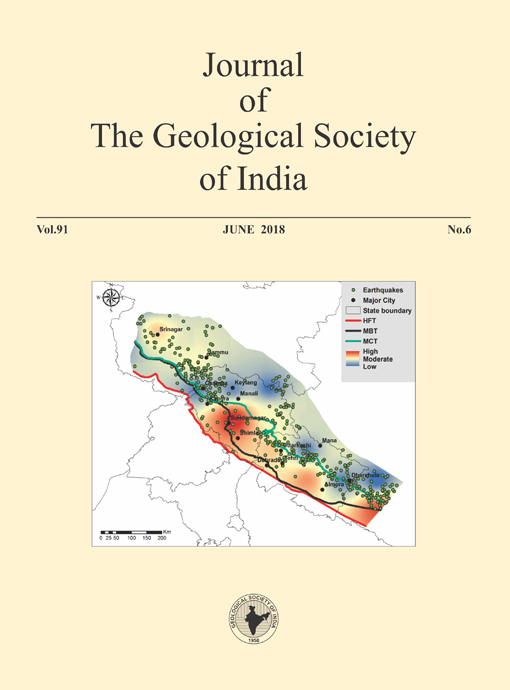Identification of Groundwater Potential Zones using Remote Sensing and GIS of K-J Watershed, India
DOI:
https://doi.org/10.1007/s12594-018-0929-3Abstract
Groundwater potential zone mapping has become easier with the inputs from Remote Sensing (RS)&Geographical Information System (GIS) techniques. Various thematic maps like geology, geomorphology, drainage density, slope, landuse/landcover etc can be easily generated through RS&GIS. The present study is aimed at generating groundwater potential map of Koshalya- Jhajhara (K-J) watershed by using integrated approach of RS&GIS. Various thematic layers have been generated and assigned weightages and ranks. These layers have been integrated in GIS software for generating Groundwater Potential Zone (GPZ) map of K-J watershed. The area falls into five categories of groundwater potential zones i.e. very good, good, moderate, poor and very Poor depending on the likelihood of availability of ground water. On the basis of this study it is found that only 5.83 km2 and 4.91 km2 area is under very good and good category of groundwater availability respectively. An area of 24.48 km2 is found under moderate category whereas dominant portion of K-J watershed i.e. 61.83 km2 and 37.87 km2 area falls under poor and very poor category of availability of groundwater respectively.Downloads
Metrics
Issue
Section
Downloads
Published
How to Cite
References
Bhatia, A.K. (2013) Ground water Information Booklet, Panchkula District, Haryana. CGWB.
Chaudhary, B.S., Kumar Manoj, Roy, A.K. and Ruhal D.S. (1996) Applications of remote sensing and geographic information systems in groundwater investigations in Sohna block, Gurgaon district, Haryana (India). International Archives of Photogrammetry and Remote Sensing., v.31(B6), pp.18-23.
Chaudhary, B.S. and Aggarwal, S. (2009) Demarcation of paleochannels and Integrated groundwater resource mapping in parts of Hisar District, Haryana. Jour. Indian Soc. Remote Sensing., v.37, pp.251-260.
Chaudhary, B.S. and Kumar, S. (2017) Use of RS and GIS for Land Use/Land Cover Mapping of K-J Watershed, India. Int. Jour. Advances in Remote Sensing and GIS., v.5(1), pp.85-92.
Horton, R.E. (1945) Erosional Development of Streams and their Drainage Basin, Hydrophysical approach to Quantitative Morphology. Geol. Soc. Amer. Bull., v.56, pp.275-370.
Javed, A. and Hussain, W.M. (2009) Delineation of groundwater potential zones in Kaknud Watershed, Eastern Rajasthan, Using Remote Sensing and GIS Techniques. Jour. Geol. Soc. India, v.73(2), pp.229-236.
Khan, A.U. and Prasad, S. (1998) Geological quadrangle map 53F. Geological Survey of India.
Kumar, S. and Chaudhary, B.S. (2016) GIS Applications in Morphometric Analysis of Koshalya-Jhajhara Watershed in Northwestern India. Jour. Geol. Soc. India, v.88, pp.585-592.
Malik, J. N. and Nakata, T. (2003) Active faults and related Late Quaternary deformation along the Northwestern Himalayan Frontal Zone, India. Annals of Geophys., v.46(5), pp.917-936.
Mishra, R.C., Chandrasekhar, B and Naik, R. D. (2010) Remote Sensing and GIS for Groundwater Mapping and Identification of Artificial Recharge Sites. GeoShanghai Internat Conf., pp.216-223.
Nakata, T. (1972) Geomorphic History and Crustal Movements of Foothills of the Himalaya. Sendai, Inst. of Geography, Tohoku Univ., pp.77.
Nandishkumar, L., Karthick, M., Arul, P. A., Lokpal, B.D.D., Revathy, S.S and Sureshbabu, S. (2014) Mapping the Groundwater Potential Zone for Bengaluru Urban District. Internat. Jour. Computer Science and Information Technologies., v.5, pp.1427-1431.
Narendra, K., Rao, N.K. and Latha, S.P. (2013) Integrating remote sensing and GIS for identification of groundwater prospective zones in the Narava basin, Visakhapatnam region, Andhra Pradesh. Jour. Geol. Soc. India, v.81(2), pp.248-260.
Singh, V. and Tondon, S.K. (2008) The Pinjaur dun (intermontane longitudinal valley) and associated active mountain fronts, NW Himalaya: Tectonic geomorphology and morphotectonic evolution. Geomorphology., v.102, pp.376-394.
Singh, V. and Tondon, S.K. (2009) Integrated analysis of structures and landforms of an intermontane longitudinal valley (Pinjaur dun) and its associated mountain fronts in the NW Himalaya. Geomorphology., v.114, pp.573-589.
Yeh Hsin-Fu, Cheng Youg-Sin, Lin Hung-I., Lee Cheng-Haw. (2016) Mapping groundwater recharge potential zone using a GIS approach in Hualian River, Taiwan. Sustainable Environment Research, pp.33-43.

 B. S. Chaudhary
B. S. Chaudhary






